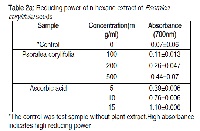In vitro evaluation of anti oxidant activity and estimation of total flavonoids in seeds of Psoralea corylifolia plant extracts
Keywords:
Psoralea corylifolia, DPPH Method, Reducing power method, n-hexane extract, ethyl acetate extract, total flavonoid contentAbstract
The present study aims at in-vitro evaluation of anti oxidant activity of n-hexane and ethyl acetate extracts of seeds of Psoralea corylifolia. For evaluating this study 1, 1-diphenyl-2-picryl-hydrazyl (DPPH) method and reducing power method was used.For DPPH method Butylated Hydroxy Anisole (BHA) was used as a positive control and for Reducing power method ascorbic acid was used as a standard reducing agent. All the analysis was made with the use of UV-Visible Spectrophotometer. The content of total flavonoids was measured spectrophotometrically by using the aluminium chloride colorimetric assay where catechin was used as a standard. The extracts showed good DPPH radical scavenging activity and reducing power activity which was found to increase with the increasing concentration of the extracts. The total flavonoid content was found to be 73.09 mg CE/100g. Ethyl acetate extract of Psoralea corylifolia showed more prominent activity when compared to n-hexane extract which could be attributed to the presence of flavonoid content.The study could be further extended to isolate and characterize phytoconstituents from these extracts.
References
Polterait O. Antioxidants and free-radical Scavengers of Natural origin. Current Org. Chem. 1997, 1: 415-440.
Nakayoma J, Yamada M, Osawat, Kawakishi S. Suppression of active oxygen-induced cyto toxicity by flavonoids. Biochem. Pharmcol. 1993, 45: 265-267
Gordon MC, David JN. Natural product drug discovery in the next millennium. Pharm Biol. 2001, 39: 8-17.
Wink M. Introduction: Biochemistry, role and biotechnology of secondary products.In Biochemistry of plant secondary metabolism,Annual plant reviews: CRC Press, Boca Raton, FL; 1999. p 1-16.
Devasagayam TPA, Tilak JC, Boloor KK. Review: Free radicals and antioxidants in human health: Curr. Stat. Fut. Prosp. JAPI. 2004, 52: 794-804.
Lee SE, Hwang HJ, Ha JS. Screening of medicinal plant extracts for antioxidant activity. Life Sci. 2003, 73: 167-179.
Ronald L Prior. Fruit and vegetables in the prevention of cellular oxidative damage. Am .J. Clin. Nutri. 2003, 78: 570S-578S.
Qiao CF, Han QB, Song JZ, Mo SF, Kong LD, Kung HF, Xu Hxl. Quality assessment of Fructus Psoraleae.Chem. Pharm. Bull. 2006, 54: 887–890.
Mukherjee PK. Quality Control of Herbal Drugs: An Approach to Evaluation of Botanicals; New Delhi: Business Horizons. 2002: p 761–763.
Rastogi RP, Mehrotra BN. Compendium of Indian Medicinal Plants Vol. 2. CDRI and New Delhi: NISCIR; Lucknow: 1999, p 567–568.
Rajpal V. Standardization of Botanicals; New Delhi: Eastern Publishers; Vol. 2. 2005: p 284–295.
Rastogi RP, Mehrotra BN. Compendium of Indian Medicinal Plants; Lucknow, CDRI and New Delhi: NISCIR. Vol. 1 2004: p 332–333.
Sah P, Agrawal D, Garg SP. Isolation and identification of furocoumarins from the seeds of Psoralea corylifolia L. Ind. J. Pharma. Sci. 2006, 68: 768–771.
Khandelwal KR. Practical Pharmacognosy,Nirali Prakashan,1995: p 149-155
Koleva II, Van Beek TA, Linssen JP, de Groot A, Evstatieva LN. Screening of plant extracts for antioxidant activity: A comparative study on three testing methods. Phytochem Anal. 2002; 13: 8–17.
Mathiesen L, Malterud KE, Sund RB. Antioxidant activity of fruit exudate and c-methylated dihydrochalcones from Myrica gale. Planta. Med. 1995, 61: 515–518.
Yildirim A, Mavi A, Kara AA. Determination of antioxidant and antimicrobial activities of Rumex crispus L. extracts. J. Agri. Food Chem. 2001, 49: 4083–4089.
Lu Y &Y. Foo. Antioxidant activities of polyphenols from sage (Salvia officinalis). Food Chem. 2001; 75: 197–202.
Marinova D, Ribarova F, Atanassova M. Total phenolics and total flavonoids in Bulgarian fruits and vegetables .J. univ.of chem. techno and met.2005; 40(3): 255-260.



